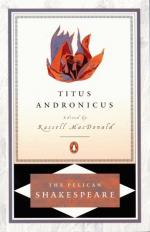|
This section contains 3,357 words (approx. 12 pages at 300 words per page) |

|
SOURCE: "Roman and Goth in Titus Andronicus," in Shakespeare Studies: An Annual Gathering of Research, Criticism, and Reviews, Vol. VI, 1970, pp. 27-34.
In the following excerpt, Broude relates Shakespeare's depiction of Romans and Goths in Titus Andronicus to Elizabethan perceptions of the strengths and weaknesses of the two cultures. The alliance of Romans and Goths that restores order to Rome, he suggests, represents a providential joining of the virtues of both cultures.
A number of Shakespearean scholars have remarked the importance of political themes in Titus Andronicus, and have observed that the ending of this early Shakespearean tragedy, in which the Romans and Goths are united under the empery of Lucius, signals the regeneration of the Roman commonweal. Nevertheless, the case for the centrality of political concerns in Titus has never been altogether satisfactory, for the conclusion of the play has never seemed thoroughly convincing. The incorporation of...
|
This section contains 3,357 words (approx. 12 pages at 300 words per page) |

|


